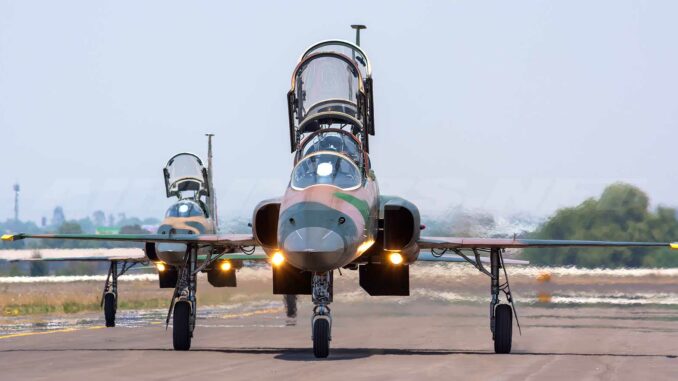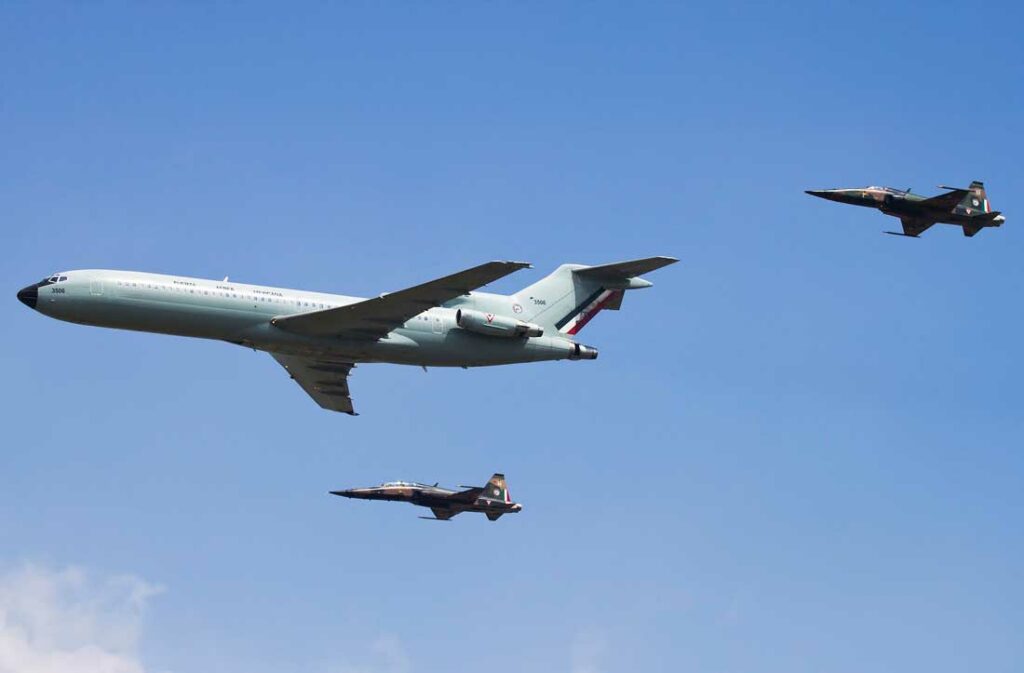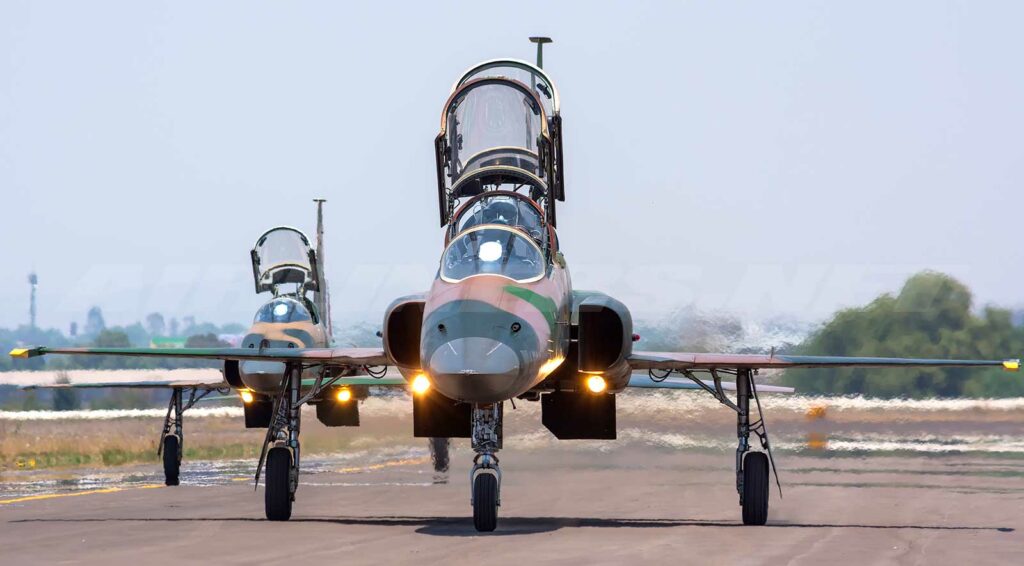
The Mexican Air Force relies on aging aircraft. Analysis of modernization needs in light of current challenges and regional capabilities.
A neglected strategic issue
Mexico’s air force is currently based on aging platforms, most of which date back to the 1980s. While the country occupies a major geopolitical position in North America, its ability to defend its airspace effectively remains a subject of debate. The stakes are not only military, but also political, economic, and symbolic.
The Fuerza Aérea Mexicana (FAM), despite having more than 390 aircraft, has very few combat aircraft capable of ensuring air superiority against modern threats. Its only fighter squadron, equipped with F-5E/F Tiger II aircraft, is now obsolete, both technologically and tactically. These aircraft were designed in the 1970s, purchased by Mexico in the 1980s, and have neither modern weapon systems nor radars that meet current standards. The lack of renewal or real upgrading raises the question of the relevance of such a fleet in the context of 2025.
This article provides a technical and strategic analysis of the reasons why Mexico might (or might not) consider modernizing its fighter aircraft fleet. We will examine current capabilities, geopolitical risks, structural limitations, and concrete options available.

An obsolete fleet facing modern demands
Platforms at the end of their life cycle
The core of the FAM’s combat capabilities rests on a handful of F-5E/F Tiger II aircraft, only a few of which are operational. These aircraft were designed for light interception and tactical support missions in uncontested environments. Their Emerson AN/APQ-159 mechanically scanned radar does not allow for long-range detection or effective multi-target management. Their communications, navigation, and electronic warfare systems no longer meet current standards.
At the same time, the rest of the fleet consists of turboprop aircraft (such as the PC-7 and PC-9) and training jets (T-6 Texan II). These aircraft have no real air combat capability. This means that, in 2025, Mexico will not have a single fully operational fighter aircraft that is interoperable with modern forces or armed with medium-range air-to-air missiles.
A significant technological gap
The gap with regional air forces is striking. Brazil has modernized F-5s, Gripen NG (ordered and currently being delivered), and even MALE (medium altitude, long endurance) drones. Chile operates F-16 MLUs. Colombia is considering replacing its Kfirs with 4.5-generation aircraft. All these countries have platforms with AESA radar, active air-to-air missiles (AIM-120, Derby, etc.) and tactical data links.
Mexico, on the other hand, has invested neither in the electronic modernization of its aircraft nor in the purchase of new platforms, leaving its air defense system at a standstill.
A specific but not neutral security context
The absence of a direct state threat
The main argument put forward by Mexico for not modernizing its fighter aircraft remains the absence of a conventional threat. The country has not experienced any interstate conflict for over a century and its security priorities are focused on fighting cartels and domestic operations.
However, this is only part of the picture. Air sovereignty is a fundamental component of any credible defense policy. The country has no long-range ground-to-air defense system. In the event of an airspace violation by an uncooperative actor, it would be unable to respond quickly with credible air assets.
Implicit strategic dependence on the United States
Geographical and diplomatic proximity to the United States creates a form of indirect protection. But this dependence severely limits Mexico’s strategic autonomy. If Washington were ever to revise its priorities or restrict its military cooperation, Mexico’s vulnerability would immediately become apparent.
An operational fleet of fighter jets would not only enable Mexico to respond to aggression. It would also strengthen surveillance, deterrence, and airspace control missions, particularly in maritime and border areas where illegal air activity is frequent.
Structural obstacles to modernization
A limited defense budget
Mexico’s military budget represents less than 0.5% of GDP, or around $7.6 billion per year. A tiny fraction of this is allocated to the air force. By comparison, Brazil spends nearly $20 billion on defense, with a significant air force.
Modernizing a fleet of 20 to 24 fourth- or fourth-and-a-half-generation fighter jets would cost between $850 million and $1.5 billion, depending on the platform (Gripen, F-16, T-50, M-346 FA, etc.), not including infrastructure, training, and maintenance costs. This is a heavy investment that is difficult to justify politically in a country facing massive social challenges.
An inward-looking military doctrine
The Mexican military command is structured to respond to internal threats: drug trafficking, territorial control, and law enforcement. This focus has reduced the attention paid to conventional warfare or air deterrence capabilities. There is no clearly defined air doctrine for the offensive or defensive use of modern fighter aircraft.
In the absence of clear political will, the FAM’s requests remain marginal compared to those of the army and navy, which absorb the majority of the budget.

Technical options are possible but unrealistic in the short term
Platforms available to Mexico
Mexico could consider several technically viable solutions. The South Korean KAI FA-50, for example, is a modern light fighter equipped with AESA radar, an internal cannon, and AMRAAM air-to-air missiles. Its unit cost is estimated at $38 million. It is already in service with Poland, Thailand, and the Philippines.
Another option, the Gripen C/D, although slightly more expensive (over €65 million per unit), offers simplified logistics, NATO interoperability, and excellent range/performance.
A second-hand purchase of modernized American F-16s or Eurofighter Tranche 1 aircraft could also enable a partial upgrade, provided that a training and maintenance plan is put in place over several years.
The importance of a structural choice
Regardless of the model chosen, fleet modernization requires an overhaul of the support system: modernized air bases, simulators, logistics chains, and ongoing training for fighter pilots and technicians. This is a long-term transformation that requires stable political consensus. Today, that consensus does not exist.
War Wings Daily is an independant magazine.